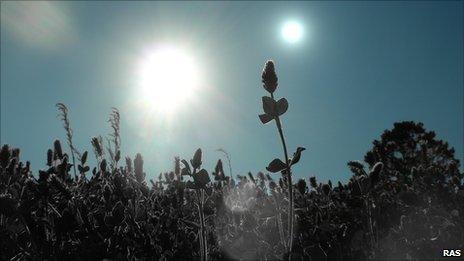Black plants 'could grow' on exoplanets with two suns
- Published

The flora may be black on distant planets orbiting dimmer stars
Plants on distant hospitable planets could have developed black foliage and flowers to survive, according to a new study.
Flora that would appear black or grey to human eyes could have evolved on planets orbiting dim "red dwarf" stars, according to unpublished research, external that is being presented at the National Astronomy Meeting in Llandudno, Wales.
This would enable plants to absorb more light to photosynthesise, using their star's light to convert carbon dioxide into organic compounds.
Jack O'Malley-James, a PhD student and astrobiologist at St Andrews University, focused on multiple star systems thought to be common throughout the universe.
He used models for star systems with two or three stars with various combinations of Sun-like and red dwarf stars. He then added planets to these models, orbiting around one or more of the stars.
Exotic plantlife
The research presumes first that plant life similar to that on Earth could evolve on an exoplanet in the "habitable zone" around its star - which is not a given, but the odds of which are difficult to estimate.
The idea then is that photosynthesis there would resemble that seen on our own planet, whereby plants use energy from the Sun to convert carbon dioxide and water into oxygen and organic compounds, such as sugars.
Flora on those planets would have to adapt to very different light conditions in order to photosynthesise.
"If a planet were found in a system with two or more stars, there would potentially be multiple sources of energy available to drive photosynthesis," said O'Malley-James.
"The temperature of a star determines its colour and, hence, the colour of light used for photosynthesis. Depending on the colours of their starlight, plants would evolve very differently."

Gliese 667 is a triple-star system with planets thought to be close in mass to our Earth
If a planet's light source comes primarily from a red dwarf, then O'Malley-James believes any possible plant life could be black or grey - but there are other outcomes which are more exotic still.
One possible scenario is a hospitable planet that receives light from both a red dwarf and a more distant Sun-like star.
This could lead to two tiers of plantlife populating the same planet - plants using light from the Sun-like star which may be brighter in colour, and a second, darker array of plants using light from the red dwarf.
"Plants with dim red dwarf suns, for example, may appear black to our eyes, absorbing across the entire visible wavelength range in order to use as much of the available light as possible," said Mr O'Malley-James.
"They may also be able to use infrared or ultraviolet radiation to drive photosynthesis. For planets orbiting two stars like our own, harmful radiation from intense stellar flares could lead to plants that develop their own UV-blocking sun-screens," he said.
Mr O'Malley-James's work is being supervised by Dr Jane Greaves of St Andrews, Professor John Raven of the University of Dundee and by Professor Charles Cockell of the Open University.
- Published13 January 2011
- Published1 December 2010